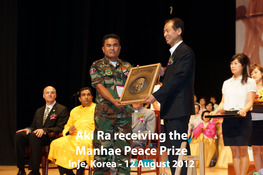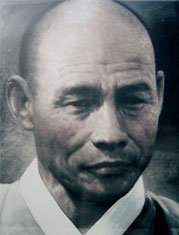Walking along the Hoan Kiem
Lake in Hanoi at sunset yesterday, we were approached by a group of
enthusiastic Vietnamese medical students who wanted to practice their
English. Sharing their admiration of American movies and music, they
inquired of us: "Why
do you come to Vietnam? What do you like about our country?"
There's something about communicating with those working to master
basic English that gives one pause. While I instinctively speak more
slowly and choose words I imagine they might easily understand, there's a
delicate art to doing so without sounding
like I'm talking to a small child. Certainly their competency with the
English language exceeds that of mine with Vietnamese. I must do my best
to honor their courageous invitation to connect by offering a
substantive exchange.
I tell them: "I am a history teacher. I bring students to Vietnam
so they can learn about the "American War," and how our countries are
now friends. The history between the U.S and Vietnam has a lot to teach
young people about the need for cross-cultural
understanding and good economic relations for a more peaceful world. I
hope my students will learn these lessons, and apply them to their
studies of other conflicts in the modern day."
The students nod, some comprehending less than others. How will they hit that conversational ball back over the net?
Dane, the boldest of my ambitious new friends, responds with a fascinating question:
"We know about America from the movies. What movies do you watch to learn about Vietnam?"
This question requires a more nuanced response, as relaying the
long list of Hollywood attempts to "win" the Vietnam War on screen
actually says more about our national psyche than it does about our
genuine understanding of anything Vietnamese.
I reply honestly: "We have so many films about the Vietnam War, but
most Americans don't learn about other countries from watching movies.
We only learn about other countries if we are personally interested to
study, read the news or travel."
I suddenly feel embarrassed, and then add lamely, "I'm sorry."
Either my apology made no sense to them, or it didn't matter
because they only smiled in response. An awkward silence followed before
the most fashionable of the group grabbed the opportunity presented by
the pop culture thread of our exchange.
"Ah. Um. Do you like the American movie Titanic?"
What a moment! spontaneously, I burst with a dramatic rendering of the soundtrack.
"Far across the distance
And spaces Between us
You have come to show you
go on..."
amazingly, the students are uninhibited and jump in to sing together with me:
"Near, far, wherever you are
I believe that the heart does go on
Once more you open the door
And you're here in my heart and
My heart will go on and on"
The laughter this evokes in all of us is so refreshingly unifying, I am awash with joy.
It's true: U.S pop culture permeates the globe, creating an
Ameri-centric view that may unhelpfully contribute to a sense of our own
entitlement, justifiable military adventures, and economic hegemony.
But sometimes it is this very ubiquity of culture
that provides the lingua Franca for cross global connection between
interested citizens of the planet.
Abstract notions of global security may not be enough motivation
for the next generation of world citizens to investigate the merits of
friendship. Maybe it is pop stars who create the universal language of
understanding?
For now, I'm grateful that my Vietnamese student friends and I both are fluent in Celine Dion.

 “One’s destination is never a place, but a new way of seeing things.” –- Henry Miller.
“One’s destination is never a place, but a new way of seeing things.” –- Henry Miller. It is hard for to put into words how significant my trip to Vietnam was in Spring 2012. It was an experience that will follow me through my entire life, one that I could never forget. Before my trip, I never knew how easy it was to change lives. It always seemed like such an idealistic concept, something only the selected few could really achieve. But I have since learned the power of one individual, the power of education, and the power independent journalism. I want to travel with Friendship Tours World Travel because it’s not only an opportunity for me to see and to learn, but to help others do the same.
It is hard for to put into words how significant my trip to Vietnam was in Spring 2012. It was an experience that will follow me through my entire life, one that I could never forget. Before my trip, I never knew how easy it was to change lives. It always seemed like such an idealistic concept, something only the selected few could really achieve. But I have since learned the power of one individual, the power of education, and the power independent journalism. I want to travel with Friendship Tours World Travel because it’s not only an opportunity for me to see and to learn, but to help others do the same. 








 The Society for the Promotion and Practice of Manhae's Thoughts established the
Manhae Prize (Manhae Daesang) in memory of, and for the dissemination of, the
high thinking and noble mind of Reverend Manhae(1879-1944).
The Society for the Promotion and Practice of Manhae's Thoughts established the
Manhae Prize (Manhae Daesang) in memory of, and for the dissemination of, the
high thinking and noble mind of Reverend Manhae(1879-1944).
